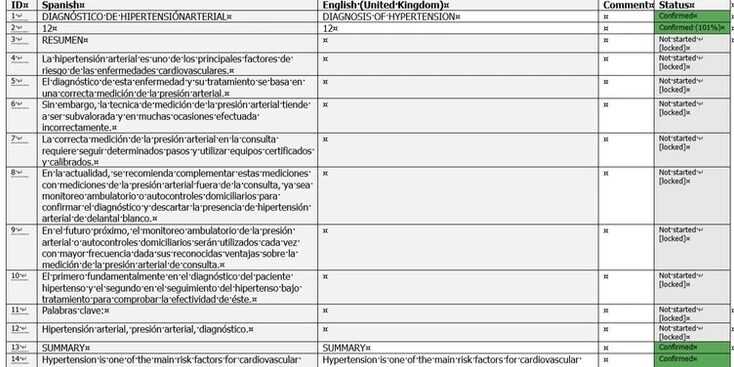Bilingual Review Files: A Productivity Aid or a Waste of Time?

This post is a reblog, originally published on Andrew Bell’s blog. It is reposted with permission from the author.
Bilingual review files come in many shapes and sizes, but they all have one thing in common, and that is that they’re meant to facilitate the revision stage of a translation project.
As you can see in the image above, the bilingual review file is made up of several columns, with one column reserved for the source text, a.k.a. the original content in a given foreign language, and another for the translation, which in my case would be in English, as well as other columns for comments and status, etc. At the end of the day, the number of columns and their purpose all boils down to which CAT tool you use (see earlier post on CAT tools), but the idea behind these files is fundamentally the same: to improve productivity and allow corrections to be implemented in the CAT tool working environment.
(Theoretical) advantages
Presenting the translation in this way is meant to increase productivity in the following ways:
• One file, two languages
The huge advantage of a bilingual review file is that you have both the original text and its translation in the same user-friendly file. This means there is no need to create a folder structure or be constantly flicking between target and source documents.
• Segmentation
The text is segmented into digestible chunks (usually sentences) which are much easier to revise than big blocks of unfriendly text. However, the segmentation is dependent on how the text was segmented in the translation stage.
• Not CAT tool dependent
This means that revisers and translators don’t have to work with the same CAT tools, or even with a CAT tool at all in the case of the reviser, to be able to work together, as the text can be directly revised in the bilingual review file.
• Track Changes
Track Changes can be used to show where the text has been amended, and this makes it easy for the translator or project manager to review the changes and either accept or reject them. Comments can also be added to the text without disrupting the layout of the document to add clarity to changes or provide additional information.
• Implement changes in the CAT tool
Once the revision stage has been carried out, the translator can upload the changes into their CAT tool in a single step. The fact this is so easy and quick to do lets the translator update their translation memories and termbases for future reference with ease.
Practical experience
When I started working as a freelance translator, my first ever assignment was actually a revision task, but to my surprise the task didn’t involve a bilingual review file. I was simply sent two separate documents, the source and target files. You can imagine my dismay; we have all this technology available to increase our productivity, yet it wasn’t being used. Alas, this was not my call to make, and I decided to crack on with the task at hand.
Not using bilingual review files actually increased my productivity
I soon discovered from working with various clients that bilingual review files weren’t actually as common as I thought they would be. But I found that this didn’t impede my productivity, it actually increased it! Now having carried out various revision tasks in this way, I’ve been able to reflect on why this is the case, and I’ve narrowed it down to one particular aspect, the top-down approach.
Top-down approach to translation
When it comes to translation, there are two approaches, top-down or bottom-up. Top-down basically means you start working with the document as a whole, and then progressively work with smaller elements within the document, whereas as you’ve probably guessed, bottom-up is the exact opposite where you work with a very specific element and progressively look at the bigger picture.
To explain how this is helpful, I’ll give you some examples.
• Formatting
Working with a target document rather than a bilingual review file allows you to pay more attention to the overall format of the document. You are able to appreciate the position of tables and images and how these may provide cues to help guide the reader through the text, something which is lost in a bilingual review file that only contains the text of a document.
I suppose the solution to this would be read the source document alongside the bilingual review file, but this counteracts the advantage of only needing to work in one document, and depending on the size of your screen, you may find that splitting your screen is not an option as the user-friendly bilingual review file becomes not so friendly when it has to share the screen.
• No segmentation
Segmentation may break down the text into easy to manage chunks, but it also encourages a bottom-up approach to translation by facilitating working at the sentence level. This can be quite a troublesome approach as even though you might come up with some excellent translations to individual sentences, if once put together they don’t form a coherent text, then your translations are useless, and you will need to start again.
With a top-down approach, you’re able to view the text in context and then break it down into appropriately sized chunks based on your judgment, rather than being at the mercy of a CAT tool. With tables, I usually find I’m most productive at the sentence level, but with the main body of text I prefer to work at the paragraph level. That way I’m able to play around with word order and make the text more concise, especially since my source languages tend to be very flexible with it comes to sentence structure.
Self-proofreading stage
Finally, I’m a huge advocate of doing one last self-check before you submit a file, whether revising or translating. One of my favorite tools for this is the “Read Aloud” function on MS Word. It rereads the text back to you, albeit in a rather robotic voice, but it lets you rest your eyes and use your listening skills for a change (but you have to look out for homophones!). I find that if I’ve been working with a text for hours on end, then my eyes are liable to betray me and let me see what I want to see rather than what is there; my ears, on the other hand, are not as forgiving when they hear something wrong. This helps me to pick up on possible mistakes that I may have missed before.
Bilingual review files are, however, not ideal when it comes to the MS Read Aloud tool as it’s unable to distinguish between the source and target columns and will reread everything to you. Working directly in the target file on the other hand avoids this problem, as the file is already monolingual. The only disadvantage in this case is that if you’ve used Track Changes, it will reread all of the text, including the original and the tracked changes, but you can choose when and where you use this tool throughout the text, so you get the most out of it.
Before I bring this post to an end, I feel like I should point out that my experience is based on working predominantly in medical and pharmaceutical translation in a limited number of language pairs, but hopefully it’s given you some food for thought to switch up your working habits every now and then, because you never know when you will find a more productive way of working. And one last thing, if you’re interested in revising directly in the target file but you’re worried about updating the translation in the CAT tool, don’t worry, most tools allow you to update the translation with an edited target document, you just might need to do a little bit of alignment in the updating process.
About the Author
 Andrew Bell MCIL (chartered linguist) is a UK-based medical and pharmaceutical translator working from Spanish, Portuguese and Catalan into English. He has a particular interest in the translation of medical journal articles and clinical trial documentation. Additionally, he regularly blogs about translation and working as a freelancer on his website. Since 2021, he has been on the committee of both the Spanish and Portuguese sub-networks of the Institute of Translation and Interpreting in the UK. You can find him online at www.belljohnsontranslations.com, and on Twitter, Instagram and LinkedIn.
Andrew Bell MCIL (chartered linguist) is a UK-based medical and pharmaceutical translator working from Spanish, Portuguese and Catalan into English. He has a particular interest in the translation of medical journal articles and clinical trial documentation. Additionally, he regularly blogs about translation and working as a freelancer on his website. Since 2021, he has been on the committee of both the Spanish and Portuguese sub-networks of the Institute of Translation and Interpreting in the UK. You can find him online at www.belljohnsontranslations.com, and on Twitter, Instagram and LinkedIn.
Recent Posts
Subscribe to Next Level
Have an idea for us?
If you have feedback or ideas for future articles, contact the Business Practices Committee.
